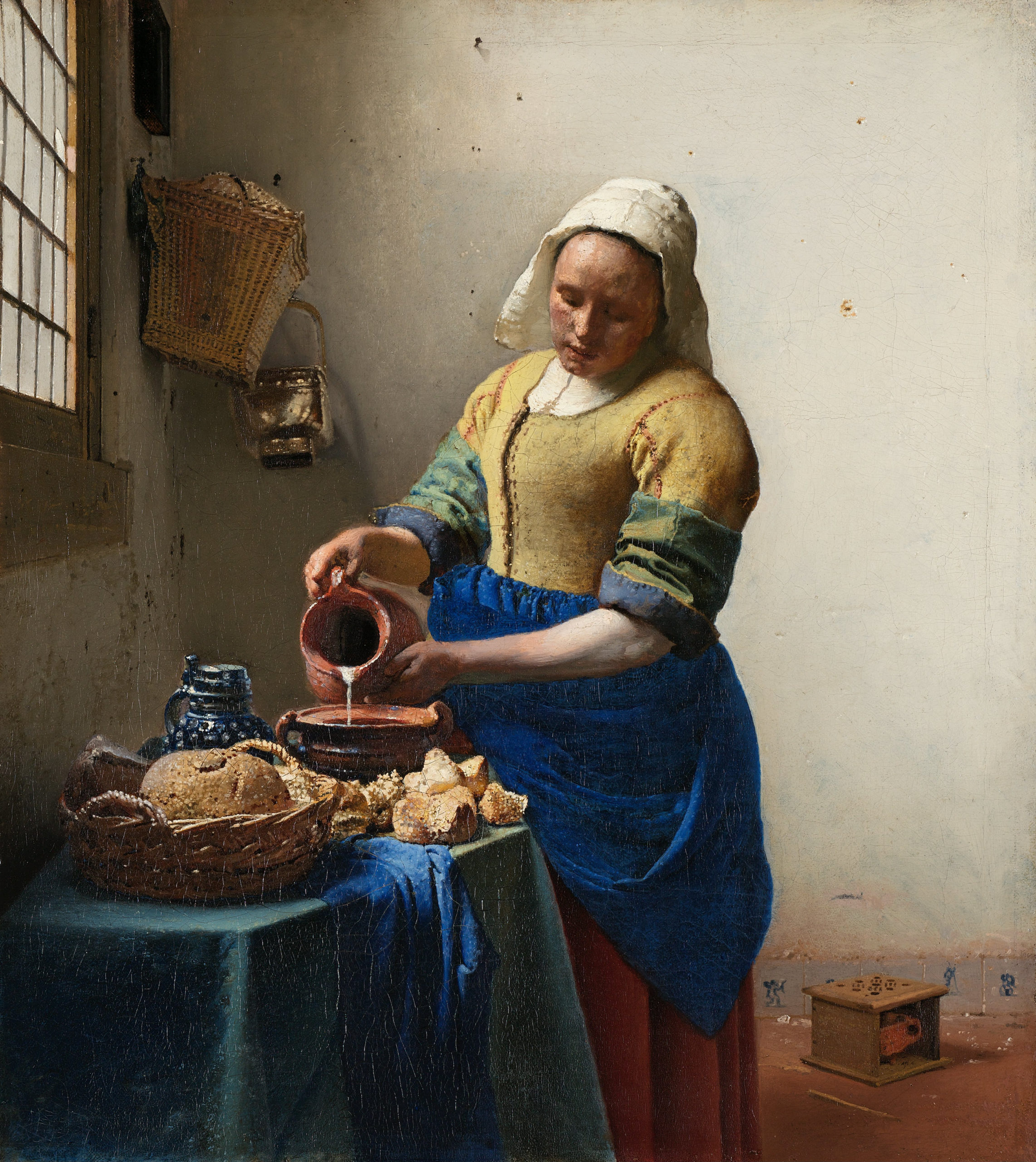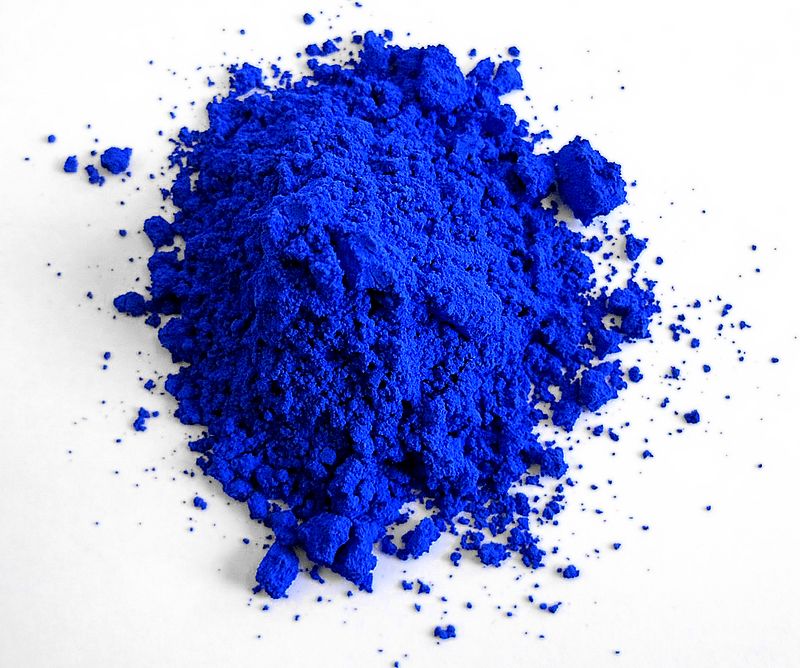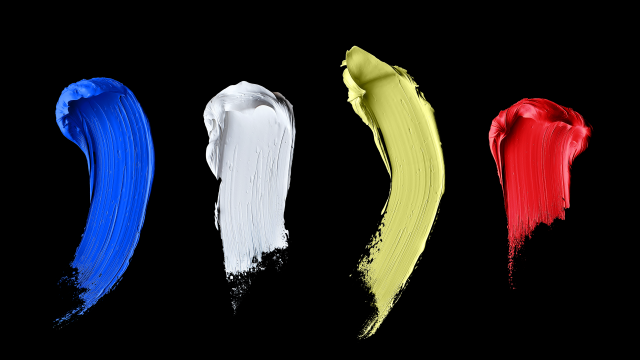In the early 18th century, German chemist Johann Jacob Diesbach was at work in a laboratory trying to make a red pigment out of cochineal insects, the tiny bugs whose extract dyes everything from food to lipstick. Diesbach hypothesised that he could combine the carmine extract with alum, iron sulfate and potash to make the pale red hue he desired. There was a problem, though. The potash Diesbach used had been contaminated, which altered the chemical makeup of his pigment. Instead of red, Diesbach had unwittingly created something far more valuable: A deep ocean-like blue.
Graphic: Jim Cooke via Shutterstock

For centuries, blue was considered one of the rarest of pigments, found only in small quantities in nature. Pigments such as lapus lazuli, made from a metamorphic rock of the same name, was said to have a value akin to precious metals such as gold. But thanks to Diesbach’s chemical mishap, the pigment could now be made synthetically; faster, cheaper and in greater quantities than ever before. Diesbach’s blue, called Prussian Blue, is considered one of the first synthetic colours to ever have been made. Since then, we’ve found many more.

It’s strange to think of colour as something that can be discovered. Ask most scientists and they will tell you that isn’t really how it works, anyway. “You can’t discover a colour,” said Mas Subramanian, a chemist at Oregon State University who in 2009 created a blue pigment called YInMN blue. “You can only discover a material that uses a particular reflection of a particular wavelength.” Semantics aside, humans have created new pigments – whether through intentional scientific inquiry or pure happenstance – for as long as we’ve been around.

Our Stone Age ancestors learned they could grind up clay to create ochre, a rich, earthy red. The ancient Egyptians mined copper carbonate hydroxide minerals in the Sinai Peninsula to produce a rare green hue. Later, during the industrial revolution, scientists used advanced chemistry to create colours though deliberate – or in the case of Prussian Blue and Tyrian purple – accidental scientific explorations. This boom in bold synthetic colours helped spawn the Impressionist art movement, since painters could more accurately recreate the colours they saw in nature. “The number of synthetic pigments have increased dramatically since then,” said Narayan Khandekar, director of Harvard’s Straus Center for Conservation and Technical Studies, where more than 2500 pigments are stored. (In a new book, An Atlas of Rare and Familiar Colour, Khandekar and his colleagues unpack the history of the collection’s pigments.)
Today, creating – and marketing – new colours is a big business. Labs that develop new pigments can spin those discoveries into huge, publicity-grabbing licensing deals (for example: Anish Kapoor’s exclusive use of Vantablack). Despite the drive to find new colours, pigment creation is still an unexpected blend of art and science. “It’s very hard to design a material that reflects a particular colour because colour is so delicate,” Subramanian said. Many of the colours you see are based on similar chemical compounds that have been tweaked slightly to produce a new colour variant. Truly novel colours are exciting, but rare.
PR254

In the early 1970s at Michigan State University, a group of chemists were embarking on an experiment to find a new form of anti-aromatic substance, a reactive, highly unstable compound made from carbon, nitrogen and oxygen. For the scientists, it was a theoretical exploration to see if such a compound was even possible. “We had no interest whatsoever in making anything that had any practical use,” recalled Donald Farnum, who led the group’s research at the time.
When Farnum and his fellow researchers combined the elements with minerals and heated them up, there result was unexpected. In the test tube they found a bright red powder, whose pigment stained anything it touched. “We recognised very quickly that it didn’t have the properties of the substance we were expecting,” he says. Farnum chalked the pigment up to a fascinating, if semi-failed experiment. He published a paper about his findings in a chemistry journal, which caught the attention of someone at the pharmaceutical company Ciba-Geigy. The chemical giant decided to synthesise Farnum’s compound thinking it might make for a useful dye. They were right.

The new F430 Ferrari is seen at the annual motor show 24 September 2004 in Paris, France. Photo: Getty
The pigment, PR254, was a goldmine. The chemical compound Farnum discovered ended up being used for semiconductors, TV pigments, and the chemical basis for more than a dozen related pigments. Today, it’s often referred to as “Ferrari red” for its use in automobile paint. Farnum didn’t get any credit for the pigment beyond his scientific paper. He holds no patents and made no money from his serendipitous discovery, which he says is all a part of science. “We didn’t make things to make money off of them for some stupid reason,” he said, laughing. “We just did it for fun.”
Lead tin yellow

Sometimes a colour’s story is lost to time. In the case of lead tin yellow, a cheery hue sometimes described as the “yellow of the old masters”, it was lost and then found again. The earliest instances of lead tin yellow were from a Romano British war painting from the third century AD, explained Nicolas Eastaugh, founder and chief scientist at Art Analysis and Research. But it didn’t come into common usage until the 13th century when painters and ceramicists would use the poisonous combination of lead and tin oxide to make the vibrant hue. Lead tin yellow, one of Johannes Vermeer‘s favourite pigments, was the predominant yellow used until the 17th century when painters replaced it with a pigment lead antimony, for reasons unknown. Eventually, lead tin yellow fell out of favour and disappeared from paintings. “Lead tin yellow was so complete with its disuse people forgot what it was,” Eastaugh said.

The pigment remained forgotten until the late 1930s when chemists started using modern pigment analysis techniques such as emission spectroscopy to identify specific elements found in pigments. The researchers would burn a sample of pigment and be able to identify the elements present based on the intensity of the flame. In 1940, the German chemist Richard Jakobi was researching the pigments in Renaissance paintings using this method, and he kept finding traces of tin. Prior to emission spectroscopy, there was no way to test for a wide array of elements – you had to know what you were looking for. “If you never thought to run a tin test, you’d never find it,” Eastaugh said. Jakobi, who effectively rediscovered lead tin yellow, decided to make a synthetic version of the canary yellow, which is now used primarily by painters who want to recreate historical painting techniques.
YInMN Blue
Like PR254, YInMN Blue was born of a failed experiment. In 2009, Mas Subramanian, a chemist at Oregon State University, and his students were exploring the electrical properties of yttrium, indium and manganese oxides to see if they could create a new material for use in semiconductors. The researchers combined the elements and heated them to around 1093C; when they took the mixture out of the furnace they noticed a blue pigment, like Cobalt, only brighter.

“I was literally shocked,” he said. Subramanian suspected the substance would be black or brown, like manganese typically is. Blue, however, was completely unexpected. “I asked my student, ‘Where did this colour come from? Are you sure you did what I asked you to do?” The student performed the experiment again, and they got the same bright blue result. That’s when Subramanian knew he had something special. ” I knew immediately this was a big discovery, so I filed for the patent,” he recalled.

Subramanian explains that blue is an uncommon pigment to stumble across, as evidenced by the discovery of Prussian Blue hundreds of years prior. YinMN is the first inorganic blue pigment to be manufactured since Cobalt in the early 19th century. And unlike Cobalt, YinMN is stable, reflects heat and doesn’t fade. After Subramanian patented YinMN compound, Shepherd Color licensed the pigment and has since turned it into paints and plastics. Last year, Crayola dedicated a new crayon colour to YinMN, a rich blue hue that they named, appropriately, “Bluetiful”.
Titanium white
You know titanium white, even if you don’t know its name. The pigment is the predominant white of the modern age; its titanium dioxide compound forming the coloured basis for a host of unexpected items. “You can find it in everything from most house paint to sunscreen to food colouring,” Eastaugh said. “I believe it is added to skimmed milk.”
Titanium white is the result of chemists searching for a non-toxic alternative to Lead White, a brilliant white used for centuries that had an unfortunately deadly edge. Though it’s now known as an abundant mineral, titanium wasn’t discovered until the end of the 18th century by the chemist William Gregor. For more than a century, chemists tinkered with the element, creating various compounds that would produce hues that were always a little bit off. Then in the early 20th century, chemists in Norway and the United States struck on a compound that made an opaque, milky white that had a high tinting strength and was non-toxic.
Eastaugh says the creation of titanium white wasn’t so much a discovery – though scientific discoveries played a role in its creation – but a deliberate use of technology to find a commercial application for a suddenly-abundant element. “Some things are quite serendipitous, other things are created by quite deliberate efforts,” he said. “This reflects the processes and technologies of the time.” Still, its impact on the art world is undeniable. “For us, dealing with authenticity of paintings, it is a discovery that is key to identifying fakes of early 20th century paintings,” he explained. Titanium white stood as a marker of time between the early and late works of certain artists. “An artist like Picasso wouldn’t have used it earlier in his career, but by the 1940s or ’50s would have, Eastaugh said. “So a 1920s or 1930s Picasso with titanium white in it is automatically suspect.”
